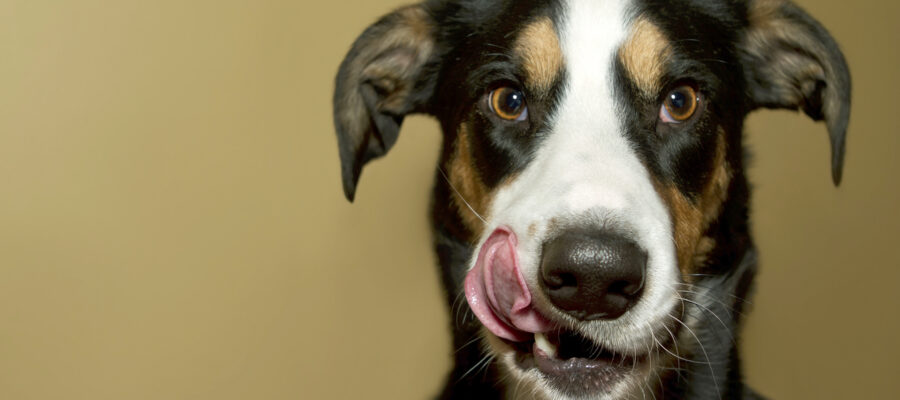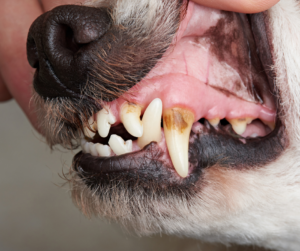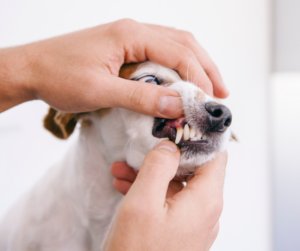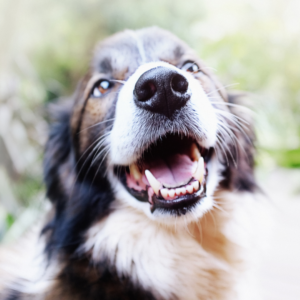10 Signs of Dental Disease In Pets You Might Be Overlooking

By Carol Bryant, Professional Pet Blogger
 Dental disease in pets has a way of sneaking up on pet parents. By age three, 8 out of 10 dogs and 7 out of 10 cats show signs of periodontal disease with potential bone loss.
Dental disease in pets has a way of sneaking up on pet parents. By age three, 8 out of 10 dogs and 7 out of 10 cats show signs of periodontal disease with potential bone loss.
Plaque, dog breath, and broken teeth are all common issues, but there are more sinister forms of dental disease in pets that get overlooked. Fortunately, knowing what to look for is the key to stopping dental problems from progressing in your dogs and cats.
Here are ten signs of dental disease to pay attention to in your pets, along with fact-filled advice to keep their mouths and teeth in tip-top shape.
- Bleeding Gums
- Pawing or Rubbing at the Mouth
- Dropping Food While Eating
- Chewing on One Side of the Mouth
- Sneezing or Nasal Discharge
- Won’t Play with Toys
- Swollen Face
- Excessive Drooling
- Irritability or Change in Behavior
- Resistance to Having Their Face or Mouth Touched
 How To Examine Your Pet’s Mouth at Home
How To Examine Your Pet’s Mouth at Home
Retract your pet’s lips into a smile, and look at the teeth and gums. The gums should be pink and free of bumps and ulcers. The teeth should be white.
Excess tartar will make teeth look yellow or brown. Pay attention to any loose or broken teeth. Take a whiff here, too. A smelly mouth may indicate periodontal disease.
Make sure there is no food matter, bits of debris, or wads of hair wedged between the teeth, lodged on the roof of the mouth, or caught under the tongue. Examine the lips for ulcers or cracks.
Did you know dogs and cats suffer from dry mouth? The medical term for dry mouth is xerostomia. Be sure to read this article about dry mouth signs, causes, and symptoms in pets.
 How To Care For Your Pet’s Teeth At Home
How To Care For Your Pet’s Teeth At Home
If you’ve never attempted to care for your pet’s teeth, there’s no better time than the present. The only effective treatment for your pet’s dental pain is to address the underlying issue. Follow these steps to better dental hygiene in dogs and cats:
- Start with a thorough dental examination from the veterinarian. They can decide if your pet needs a professional cleaning under anesthesia. This allows you to start with a clean slate.
- Follow veterinary instructions. Your veterinarian may recommend full-mouth digital radiographs to assess all teeth’ anatomy and health, bone structure, and root health.
- Be proactive and begin an oral care regimen at home. Read my article if your pet does not like anyone touching their mouth. It can be done with patience and practice.
- Incorporate Oratene® Brushless Oral Care products into your daily routine. Each product in the line was developed for ease of use, is antibiotic-free, uses a patented LP3 enzyme system, and is affordable. Here are our recommendations:
- Oratene Enzymatic Water Additive: Flavorless, freshens breath, promotes healthy teeth and gums, manages dry mouth, prevents plaque build-up and odor-causing germs.
- Oratene Enzymatic Brushless Toothpaste Gel: No brush needed, same benefits as the water additive, flavorless and simple to use.
- Oratene Enzymatic Brushless Breath Freshener: Spray three pumps onto teeth, gums, and cheeks. It is great for on-the-go.
- Feeding a healthy, well-balanced diet. This is important for overall good health.
- Read treat labels. Some products contain unnecessary sugars and salt that pets do not need.
- Clean the water bowl regularly. Ensure your pet has access to clean, fresh water to help rinse away food particles and bacteria.
- Practice positive reinforcement. Make dental care a positive experience by praising your pet and limiting practice oral care sessions to a few seconds. Gradually increase the time.
- Avoid hard objects. Hard chews like bones or antlers may harm teeth and cause fractures.
- Offer dental chews. Read labels, look for more natural ingredients, and always offer a size-appropriate chew so your pet does not choke. Always monitor your pets when eating treats and chews.
Can Kibble Clean My Dog’s Teeth?
In a word, no. Believing kibble cleans a dog’s teeth is the equivalent of chewing pretzels and hoping it cleans tartar off human teeth.
According to holistic veterinarian Dr. Judy Morgan, “Kibble can contribute to dental disease in that it is ultra-processed at high heats. High heat processing has been shown to increase inflammation and periodontal disease in the body. Kibble contains starches and fillers that break down into sugar, contributing to plaque and bad bacteria build-up. A study in Australia showed that dental health declined in just 17 days after switching from a raw to a kibble diet in dogs. Another study showed higher dental disease in cats fed a dry food diet versus feral cats eating a (raw) diet in the wild.”
Check out our Frequently Asked Questions page for more about pet dental care. Cheers to oral care, clean teeth, and fresh breath for your pets!
About the Author

Gayle King introduced Carol Bryant as a “dog lover of the highest order” when she and her Cocker Spaniel, Dexter, appeared on Oprah Radio. Carol is well-known in the pet industry, having appeared on television, radio shows, and podcasts, as well as in articles from CNN and Yahoo to Dogster and Today.com. She is the founder of the award-winning blog FidoseofReality.com and is the Immediate Past President of the Dog Writers Association of America.

